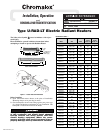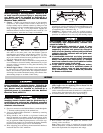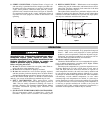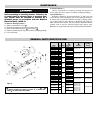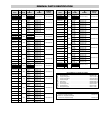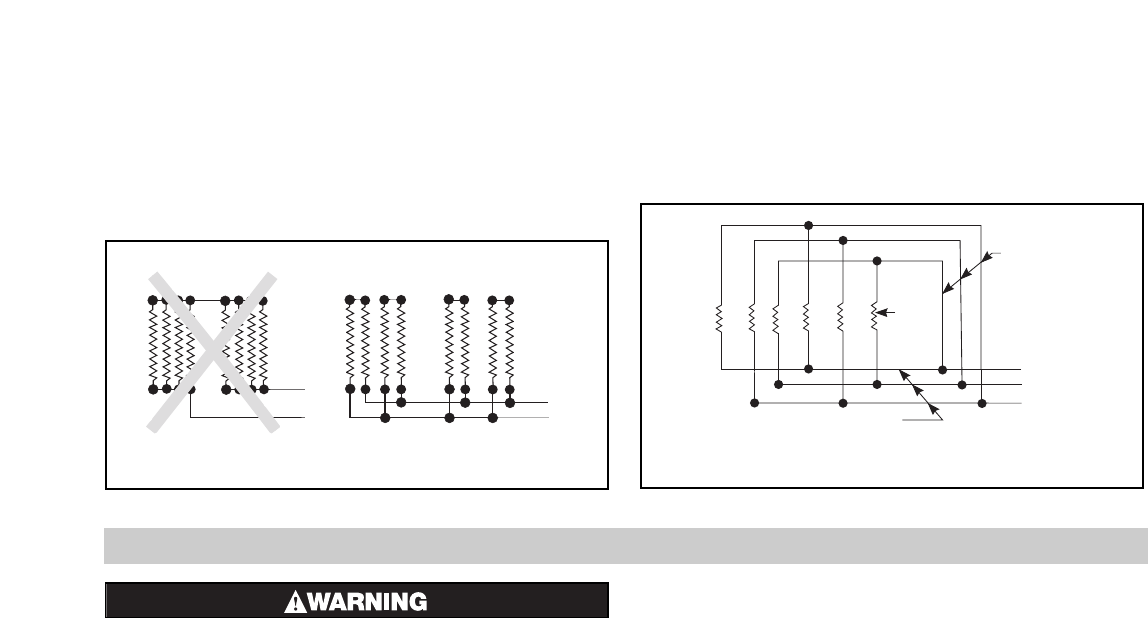
FIRE/EXPOSION HAZARD. This heater is not
intended for use in hazardous atmospheres where
flammable vapors, gases, liquids or other com-
bustible atmospheres are present as defined in the
National Electrical Code. Failure to comply can
result in personal injury or property damage.
Before energizing this heater:
1. Be sure all electrical connections are tightly made. Hold ter-
minal with pliers when tightening screw.
2. Be sure that all conductors are properly insulated.
3. Be sure that terminal box cover has been properly replaced,
and that secondary insulation bushings have not been omitted.
Standard Radiant Heaters are built to operate at 40 watts per sq.
inch on the element sheath. When it is desired to reduce radiant
intensity, one or more of the following methods may be used.
1. INPUT CONTROLLERS. These motor-driven cycling
devices can be used to vary heater output capacity from 4 to
100%. They are usually connected in holding coil circuit of
magnetic contactors. See Chromalox Radiant Heater Manual
for further information regarding Input Controllers and
Contactors.
2. SOLID STATE THYRISTOR POWER CONTROLLERS.
For best non-contact control of radiant heat, a Series #6
Chromalox Thyristor Power Controller with manual poten-
tiometer setting is recommended. Truly proportional output of
from 0 – 100% can be easily dialed-in to suit the particular
product or process requirements. The Series #6 panels are pre-
engineered, pre-packaged assemblies in an enclosure with cir-
cuit disconnect provided and ready for installation.
Maximum Ambient Temperatures —
Chromalox Radiant Heaters are not recommended for applica-
tions in ambient temperatures exceeding 450°F. Higher ambient
temperatures mean shorter heater life.
Maximum work temperature in a given time depends on sever-
al factors: Reflectivity of work, specific heat of work, mass of
work, kW input and losses from oven and time of exposure. As
work temperature increases, the work loses heat by radiation and
by convection to the surrounding ambient. Although it is a gener-
al principle of Radiant Heater application that work temperature
conventionally exceeds ambient temperature, in cases where
extremely high work temperatures are desired, it is necessary to
enclose the heaters in order to increase the ambient. If evaporation
of a liquid is desired as a result of increasing work temperature, it
is necessary to provide ventilation air in order to carry away the
evaporated liquid. Under carefully engineered circumstances, a
maximum work temperature of 600°F may be attained.
OPERATION
Wrong
Right
L1
L2
L2
L1
Radiant
Heaters
Figure 6
Radiant
Heaters
ABCD EF
3 Conductors
in 1 Conduit
L1
L2
L3
3 Conductors
in 1 Conduit
Figure 7
8. SERIES CONNECTION of Radiant Heaters of equal volt
and watt rating is permitted in all line voltages up to 600 volts.
In making such series connections it is necessary to observe the
“right” (series-parallel) connection rather than the “wrong”
(parallel-series) connection both shown in Figure 6. If heaters
are connected according to the “wrong” illustration, failure of
any heater will cause progressive failure of other heaters still
operating.
9. DELTA CONNECTIONS — When heaters occur in multiples
of three, they may be connected to, and balanced across, three-
phase lines. The most commonly used connection is the delta
connection illustrated in Figure 7.
Three phase Delta connections to minimize inductive effect in
conduits are made per this diagram. The rule: run all 3 three-phase
conductors in the same conduit as far as possible. For single-phase,
run only two conductors and follow the same rule.



